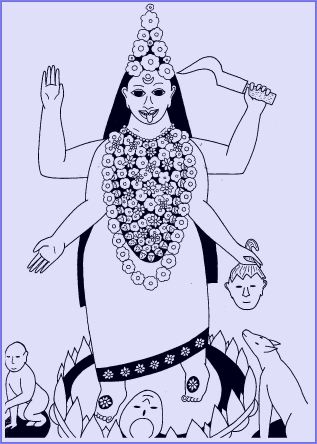Tantric temples
Most Goddess temples in India are tantric, in the sense that their images and rituals are influenced by the writings known as Tantras. The ones mentioned below are tantric in another sense too - they celebrate the Goddess not only as Mother, but also as the power of eros.
- Kamakhya Mandir, Gauhati, Assam
- Kamakhya means "She Whose Name is Desire". (Sanskrit kama is the equivalent of the Greek eros - likewise pictured as a god with bow and arrows.) In this temple, the Goddess has the form of a natural rock formation with the shape of the Yoni. A very old sacred place which today attracts hundreds of thousands of pilgrims. The Kalika Purana, which praises the power of this place, says that Kamakhya is the same Goddess as Mahamaya, 1 who is also known as Kali.2.
- Devipuram, Andhra Pradesh
- A south Indian temple, very young by Indian standards, as it was begun in 1983. Its founder, Sri Amritananda Natha, a former nuclear physicist, was inspired by a mystical encounter with the Goddess in the form of Kamakhya. The temple is built in the shape of a three-dimensional Sri Yantra, with numerous shrines containing images of shaktis. Many of these shaktis are sky-clad, their female characteristics boldly revealed. The figure at the center of this temple is known as Sahasrakshi, the thousand-eyed, and Rajarajesvari, the sovereign of sovereigns. As she is black in colour, it seems natural to think of her also as Kali, the dark lady.
1 from Tarkaratna, Pancanana (ed); Kalikapuranam [Sanskrit in Bengali script with Bengali translation]; Navabharat Publishers, Kalikata, 1977. Chapter 58 verse 53 - 56
2 Kalikapuranam Chapter 44, verse 54.
 
|


